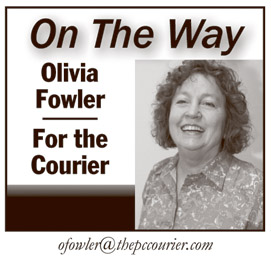Driving into our history
My brother and I went on a journey last week. We drove to Virginia together and started exploring family history. We knew all about Mama’s side of the family, but very little about Daddy’s side. So we drove into the past and discovered the other side of our history.
 We’d last lived in Virginia in early childhood, before our Daddy’s death. Little did we know how much seeing vaguely remembered places and buildings would jog memories we didn’t even know we had.
We’d last lived in Virginia in early childhood, before our Daddy’s death. Little did we know how much seeing vaguely remembered places and buildings would jog memories we didn’t even know we had.
We first went to Norfolk. Mama had a copy of my christening certificate in an old photo album. It was held in St. Paul’s Episcopal Church in Norfolk, so we first visited the church, searching for family graves. It’s a beautiful old building built before the Revolutionary War. The wall nearest the Chesapeake Bay has a British cannonball embedded in it, just below the roof.
I took a picture of the cannonball, the church, the interior and the tombstones in the cemetery. They’d stopped burying people there in 1840, but after a conversation with a very nice lady who conducted tours of the church, we learned that church members were later buried in Cedar Ridge Cemetery.
I took pictures of the suspended pulpit, a common style when the Church of England was in vogue, and we left for Cedar Ridge.
There, we visited the office, which has cemetery maps and card files on every person resting there. We found where our grandparents were buried, as well as several great-aunts.
This gave us some dates to work with.
We learned from the guide that there was another Episcopal church where others in the family may have worshiped. Old Donation Church is in nearby Virginia Beach, and we learned my grandmother’s family, the Hoggards, were active there.
So we visited the beautiful old church, met the rector and the church secretary, whose desk had a name plate identifying officially as the Guardian Angel.
They took us on a tour and found our father’s grave for us. Although we have no real memory of him, it was a moving experience to see his gravestone and know where he lies.
It was also fascinating to talk to the church historian and learn about the Hoggard family’s participation in church activities.
Our great-aunt Frances donated the organ, and our great-great-great-grandfather, Thumer Hoggard IV, kept the church from going under in his lifetime.
It’s thriving now.
From there, we were directed to Poplar Hall, the family home built in 1640. This was where our grandmother was born, and the house was in the family for eight generations. It was the site of the first American shipyard, which the family owned.
All the land around the house now has been developed as subdivisions, but the house itself is unchanged on the outside.
It is no longer owned by the family. I rang the doorbell, and when no one answered, we walked around the side and took some good pictures. It faces Broad Creek.
From there, we went to our grandmother’s house in town. It’s a three-story brownstone on West York Street facing The Hague and is still there, now occupied by a law firm. We were pleased to see it hadn’t been demolished and is in good condition. I knocked and received a very courteous reception. They conducted us over the house, which they’re in the process of restoring, and we were glad to see they had respect and appreciation for it.
That ended the second day of our journey, and we were both excited to have learned so much. The next day brought us even more information, and we followed the trail of clues given us by some very kind and helpful guides. There’s too much to tell in one column, so the story must be continued next week.




























